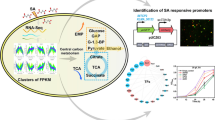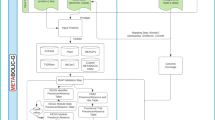Abstract
Oxidative stress is one of the major challenges faced by Arctic marine bacteria due to the high oxygen concentration of seawater, low temperatures and UV radiations. Transcriptome sequencing was performed to obtain the key functional genes involved in the adaptation to oxidative stress induced by hydrogen peroxide in the Arctic bacterium Pseudoalteromonas sp. A2. Exposure to 1 mmol/L H2O2 resulted in large alterations of the transcriptome profile, including significant up-regulation of 109 genes and significant down-regulation of 174 genes. COG functional classification revealed that among the significantly regulated genes with known function categories, more genes belonging to posttranslational modification, protein turnover and chaperones were significantly up-regulated, and more genes affiliated with chaperones and amino acid transport and metabolism were significantly down-regulated. It was notable that the expressions of eighteen genes affiliated with flagella and four genes affiliated with heat shock proteins were significantly up-regulated. Meanwhile, the expression of nine genes belonging to cytochrome and cytochrome oxidase, and five genes belonging to TonB-dependent receptor, were significantly down-regulated. Among the eighteen genes with antioxidant activity categorized by GO analysis, the expression of one gene was significantly up-regulated; however, the expressions of two genes were significantly down-regulated. Briefly, RNA-Seq indicated that, except for the classical anti-oxidative genes and stress proteins, genes affiliated with flagella and function unknown played important roles in coping with oxidative stress in Pseudoalteromonas sp. A2. This overall survey of transcriptome and oxidative stress-relevant genes can contribute to understand the adaptive mechanism of Arctic bacteria.
Similar content being viewed by others
References
Abele D, Puntarulo S. 2004. Formation of reactive species and induction of antioxidant defence systems in polar and temperate marine invertebrates and fish. Comp Biochem Physiol A Mol Integr Physiol, 138(4): 405–415
Aberg A, Hahne S, Karlsson M, et al. 1989. Evidence for two different classes of redox-active cysteines in ribonucleotide reductase of Escherichia coli. J Biol Chem, 264(21): 12249–12252
Arnér E S J, Holmgren A. 2000. Physiological functions of thioredoxin and thioredoxin reductase. FEBS J, 267(20): 6102–6109
Cabiscol E, Tamarit J, Ros J. 2000. Oxidative stress in bacteria and protein damage by reactive oxygen species. Int Microbiol, 3(1): 3–8
Casey A, Fox E M, Schmitz-Esser S, et al. 2014. Transcriptome analysis of Listeria monocytogenes exposed to biocide stress reveals a multi-system response involving cell wall synthesis, sugar uptake, and motility. Front Microbiol, 5: 68, doi: 10.3389/fmicb.2014.00068
Chattopadhyay M K. 2002. Low temperature and oxidative stress. Curr Sci, 83(2): 109
Chattopadhyay M K, Raghu G, Sharma Y V R K, et al. 2011. Increase in oxidative stress at low temperature in an Antarctic bacterium. Curr Microbiol, 62(2): 544–546
Conesa A, Götz S, García-Gómez J M, et al. 2005. Blast2GO: a universal tool for annotation, visualization and analysis in functional genomics research. Bioinformatics, 21(18): 3674–3676
Donati A J, Jeon J M, Sangurdekar D, et al. 2011. Genome-wide transcriptional and physiological responses of Bradyrhizobium japonicum to paraquat-mediated oxidative stress. Appl Environ Microbiol, 77(11): 3633–3643
Dubbs J M, Mongkolsuk S. 2012. Peroxide-sensing transcriptional regulators in bacteria. J Bacteriol, 194(20): 5495–5503
Gaupp R, Ledala N, Somerville G A. 2012. Staphylococcal response to oxidative stress. Front Cell Infect Microbiol, 2: 33
Gocheva Y G, Krumova E T, Slokoska L S, et al. 2006. Cell response of Antarctic and temperate strains of Penicillium spp. to different growth temperature. Mycol Res, 110(11): 1347–1354
Gocheva Y G, Tosi S, Krumova E T, et al. 2009. Temperature downshift induces antioxidant response in fungi isolated from Antarctica. Extremophiles, 13(2): 273–281
Imlay J A. 2013. The molecular mechanisms and physiological consequences of oxidative stress: lessons from a model bacterium. Nat Rev Microbiol, 11(7): 443–454
Jobin M P, Delmas F, Garmyn D, et al. 1997. Molecular characterization of the gene encoding an 18-kilodalton small heat shock protein associated with the membrane of Leuconostoc oenos. Appl Environ Microbiol, 63(2): 609–614
Kammer A R, Orczewska J I, O’Brien KM. 2011. Oxidative stress is transient and tissue specific during cold acclimation of threespine stickleback. J Exp Bio, 214(8): 1248–1256
Kanehisa M, Goto S. 2000. KEGG: Kyoto encyclopedia of genes and genomes. Nucleic Acids Res, 28(1): 27–30
Kanehisa M, Goto S, Sato Y, et al. 2014. Data, information, knowledge and principle: back to metabolism in KEGG. Nucleic Acids Res, 42(D1): D199–D205
Kilstrup M, Jacobsen S, Hammer K, et al. 1997. Induction of heat shock proteins DnaK, GroEL, and GroES by salt stress in Lactococcus lactis. Appl Environ Microbiol, 63(5): 1826–1837
Kim S H, Kim S K, Jung K H, et al. 2013. Proteomic analysis of the oxidative stress response induced by low-dose hydrogen peroxide in Bacillus anthracis. J Microbiol Biotechnol, 23(6): 750–758
Klatt P, Lamas S. 2000. Regulation of protein function by S-glutathiolation in response to oxidative and nitrosative stress. Eur J Biochem, 267(16): 4928–4944
Leichert L I O, Scharf C, Hecker M. 2003. Global characterization of disulfide stress in Bacillus subtilis. J Bacteriol, 185(6): 1967–1975
Li Yingying, Liu Yang, Chew S C, et al. 2015. Complete genome sequence and transcriptomic analysis of the novel pathogen Elizabethkingia anophelis in response to oxidative stress. Genome Biol Evol, 7(6): 1676–1685
Lin Xuezheng, Wang Zhen, Li Yang. 2014. Draft genome sequence of Pseudoalteromonas sp. strain A2, an isolate with high antioxidative activity from Arctic seawater. Genome Announc, 2(5): e00885-14, doi: 10.1128/genomeA.00885-14
Lister K N, Lamare M D, Burritt D J. 2010. Sea ice protects the embryos of the Antarctic sea urchin Sterechinus neumayeri from oxidative damage due to naturally enhanced levels of UV-B radiation. J Exp Bio, 213(11): 1967–1975
Liu Shenghao, Zhang Pengying, Cong Bailin, et al. 2010. Molecular cloning and expression analysis of a cytosolic Hsp70 gene from Antarctic ice algae Chlamydomonas sp. ICE-L. Extremophiles, 14(3): 329–337
Lopez-Martinez G, Elnitsky M A, Benoit J B, et al. 2008. High resistance to oxidative damage in the Antarctic midge Belgica antarctica, and developmentally linked expression of genes encoding superoxide dismutase, catalase and heat shock proteins. Insect Biochem Mol Biol, 38(8): 796–804
Mailloux R J, Lemire J, Appanna V D. 2011. Metabolic networks to combat oxidative stress in Pseudomonas fluorescens. Anton Leeuw, 99(3): 433–442
Manney G L, Santee M L, Rex M, et al. 2011. Unprecedented Arctic ozone loss in 2011. Nature, 478(7370): 469–475
Mishra S, Imlay J. 2012. Why do bacteria use so many enzymes to scavenge hydrogen peroxide?. Arch Biochem Biophys, 525(2): 145–160
Mizuno N, Sugie A, Kobayashi F. 2008. Mitochondrial alternative pathway is associated with development of freezing tolerance in common wheat. J Plant Physiol, 165(4): 462–467
Mostertz J, Scharf C, Hecker M, et al. 2004. Transcriptome and proteome analysis of Bacillus subtilis gene expression in response to superoxide and peroxide stress. Microbiology, 150(2): 497–512
Munné-Bosch S, Alegre L. 2002. The function of tocopherols and tocotrienols in plants. Cri Rev Plant Sci, 21(1): 31–57
Nachin L, Nannmark U, Nyström T. 2005. Differential roles of the universal stress proteins of Escherichia coli in oxidative stress resistance, adhesion, and motility. J Bacteriol, 187(18): 6265–6272
Pomposiello P J, Demple B. 2002. Global adjustment of microbial physiology during free radical stress. Adv Microb Physiol, 46: 319–341
Regoli F, Nigro M, Bompadre S, et al. 2000. Total oxidant scavenging capacity (TOSC) of microsomal and cytosolic fractions from Antarctic, Arctic and Mediterranean scallops: differentiation between three potent oxidants. Aquat Toxicol, 49(1–2): 13–25
Russel M, Model P. 1986. The role of thioredoxin in filamentous phage assembly. Construction, isolation, and characterization of mutant thioredoxins. J Biol Chem, 261(32): 14997–15005
Salunkhe P, Töpfer T, Buer J, et al. 2005. Genome-wide transcriptional profiling of the steady-state response of Pseudomonas aeruginosa to hydrogen peroxide. J Bacteriol, 187(8): 2565–2572
Shiu C T, Lee T M. 2005. Ultraviolet-B-induced oxidative stress and responses of the ascorbate-glutathione cycle in a marine macroalga Ulva fasciata. J Exp Bot, 56(421): 2851–2865
Smith R C, Prezelin B B, Baker K S, et al. 1992. Ozone depletion: ultraviolet radiation and phytoplankton biology in Antarctic waters. Science, 255(5047): 952–959
Tatusov R L, Fedorova N D, Jackson J D, et al. 2003. The COG database: an updated version includes eukaryotes. BMC Bioinform, 4(1): 41
Thomas D N, Dieckmann G S. 2002. Antarctic sea ice-a habitat for extremophiles. Science, 295(5555): 641–644
Wang Ge, Alamuri P, Maier R J. 2006. The diverse antioxidant systems of Helicobacter pylori. Mol Microbiol, 61(4): 847–860
Wang Zhong, Gerstein M, Snyder M. 2009. RNA-Seq: a revolutionary tool for transcriptomics. Nat Rev Genet, 10(1): 57–63
Acknowledgements
We thank the sampling assistances of the 5th Chinese National Arctic Expedition.
Author information
Authors and Affiliations
Corresponding author
Additional information
Foundation item: The National Natural Science Foundation of China under contract No. 41176174; the Public Science and Technology Funds for Ocean Projects under contract No. 201205020-5.
Rights and permissions
About this article
Cite this article
Lin, X., Wang, Z., Li, Y. et al. Genome-wide transcriptional response of the Arctic bacterium Pseudoalteromonas sp. A2 to oxidative stress induced by hydrogen peroxide. Acta Oceanol. Sin. 35, 73–80 (2016). https://doi.org/10.1007/s13131-016-0892-z
Received:
Accepted:
Published:
Issue Date:
DOI: https://doi.org/10.1007/s13131-016-0892-z




